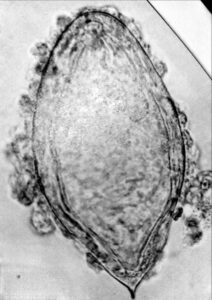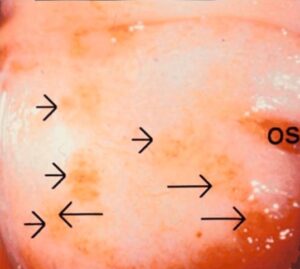Schistosomiasis is a chronic inflammatory disorder that is initiated by infection with Schistosoma blood fluke parasites and which causes tissue damage and systemic pathology that often persist into adulthood, even after infection abates.
Anti-schistosomal, immune-mediated pathology is the primary cause of both systemic and organ-specific morbidity.
Presentation of disease among long-term residents of Schistosoma-endemic areas differs from the disease presentation seen among travelers or migrants who have had only short-term exposure to the parasite.
Transmission of Schistosoma spp. parasites require specific intermediate host snails – human prevalence is closely tied to the abundance of suitable snail host species in local freshwater habitats.
New dams, irrigation and urbanization and enhance local snail habitat and increase local transmission. This typically results in a dramatic increase in local prevalence of schistosomiasis. The specie involved in this infertility is Schistosoma haematobium.

Schistosoma haematobium an agent of infertility
REPRODUCTIVE ORGAN INVOLVEMENT
Schistosoma haematobium parasitizes the vesical plexus, eggs are found in both male and female genital organs.
In males, the mean Schistosoma haematobium egg count/g of seminal vesicle tissue was 20 000 in one investigation. The resultant enlargement, muscular hypertrophy and fibrosis produced an increase in weight of the seminal vesicle that correlated with the presence of obstructive uropathy. Much less commonly affected were the prostrate, testes, epididymis and penis. Haematospermia is often a presenting symptom of genitourinary schistosomiasis. Orchitis, prostatitis, dyspareunia and oligospermia have been associated with male genital schistosomiasis have been shown to resolve after anti-schistosomal therapy.
In females, the findings of eggs in the female genital organs is similarly frequent; eggs may be found in the vulva, or cervix, where friable polypoid or nodular lesions and sandy patches may be seen.
Nodules in the perianal skin are not rare. The internal female genital organs – ovaries, fallopian tubes and uterus – are much less commonly affected.
However, pelvic schistosomiasis can cause reversible and irreversible female infertility. Female genital schistosomiasis is increasingly recognized as a co-morbid condition with HIV/AIDS in sub-saharan Africa.

Female genital schistosomiasis
There is a dearth of recent reports associating ectopic pregnancy or infertility and S. haematobium infection.
DIAGNOSIS
Diagnosis of active infection is established by detection of Schistosoma eggs in urine, stool or tissue biopsies. Positive antigen testing and/or serology support the diagnosis in egg-negative cases.
Patient manifestations of schistosomiasis range from sub-clinical disease (including anemia and growth retardation) to overt multisystem organ failure.
TREATMENT
Praziquantel is the drug of choice for treating all forms of established Schistosoma infection.
Regular treatment with anti-schistosomal drugs decreases morbidity among endemic populations.
Full prevention of Schistosoma-related disease requires interruption of transmission in order to prevent early infection and rapid recurrence of infection during childhood.
REFERENCES
CURRENT Medical Diagnosis and Treatment 2013 Papadakis et. al.
MANSON’S TROPICAL DISEASES 22ND EDITION
MANSON’S TROPICAL DISEASES 23RD EDITION
ATLAS OF HUMAN PARASITOLOGY 4TH EDITION


